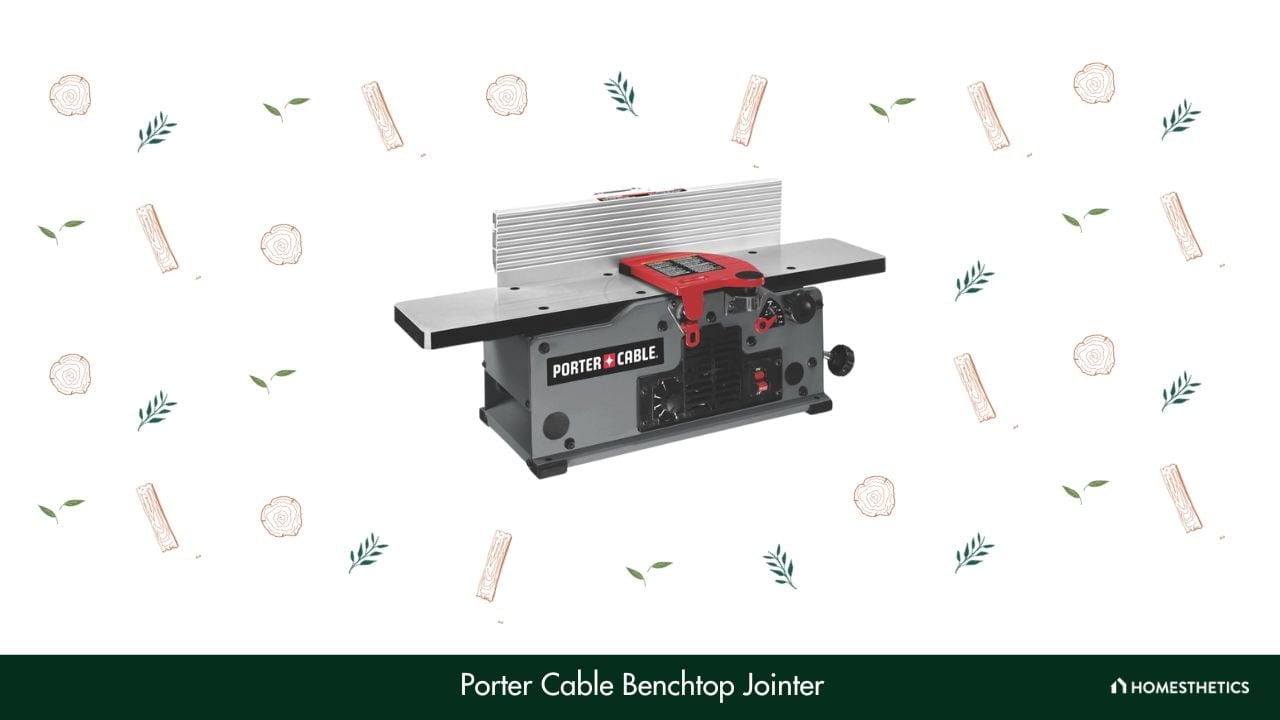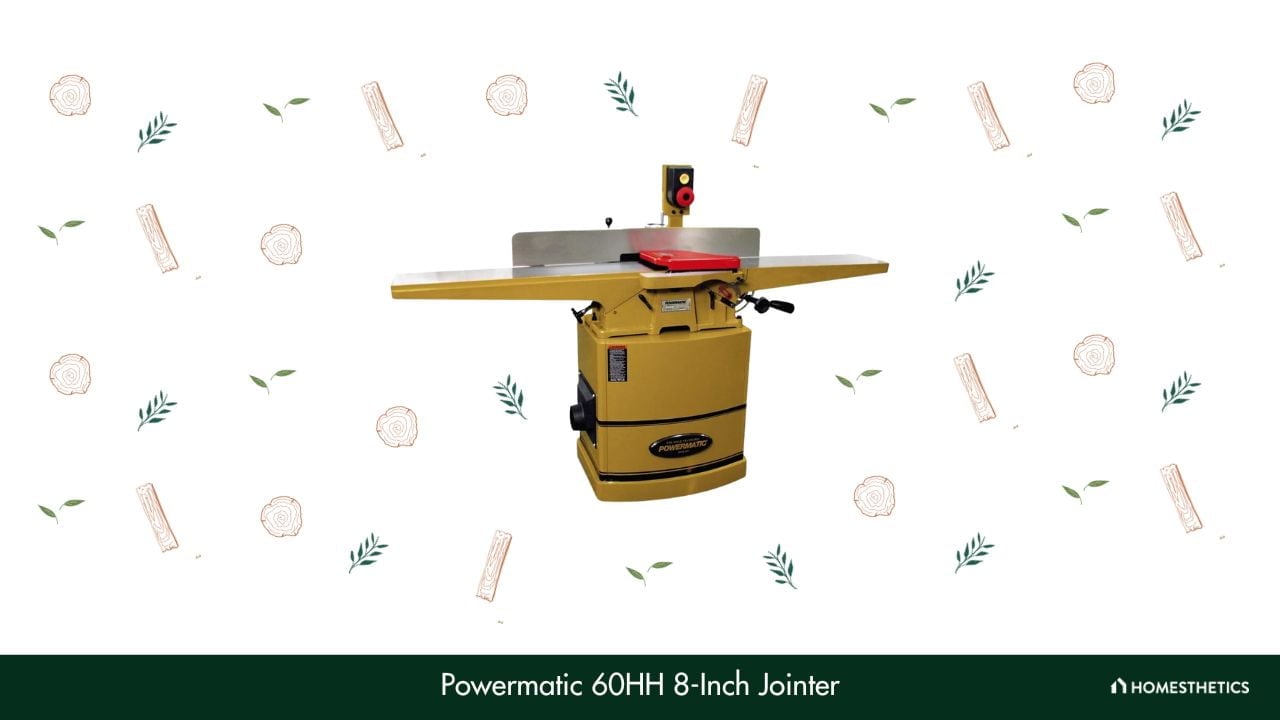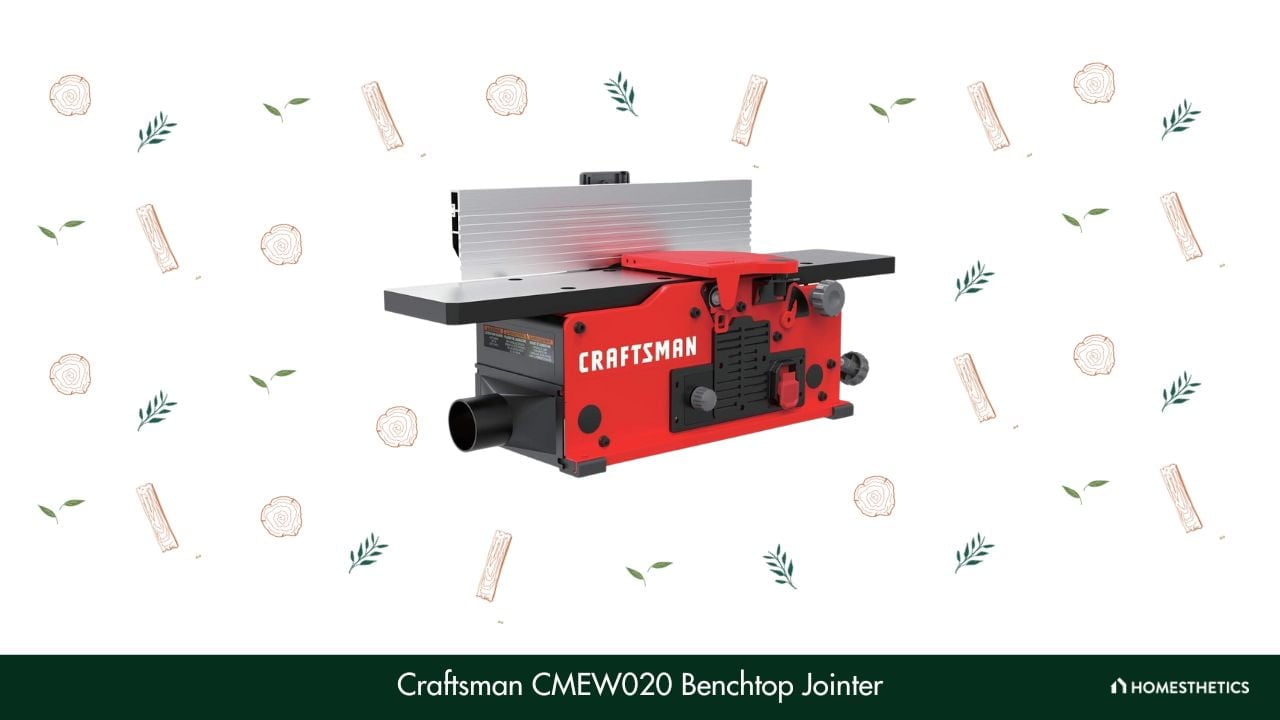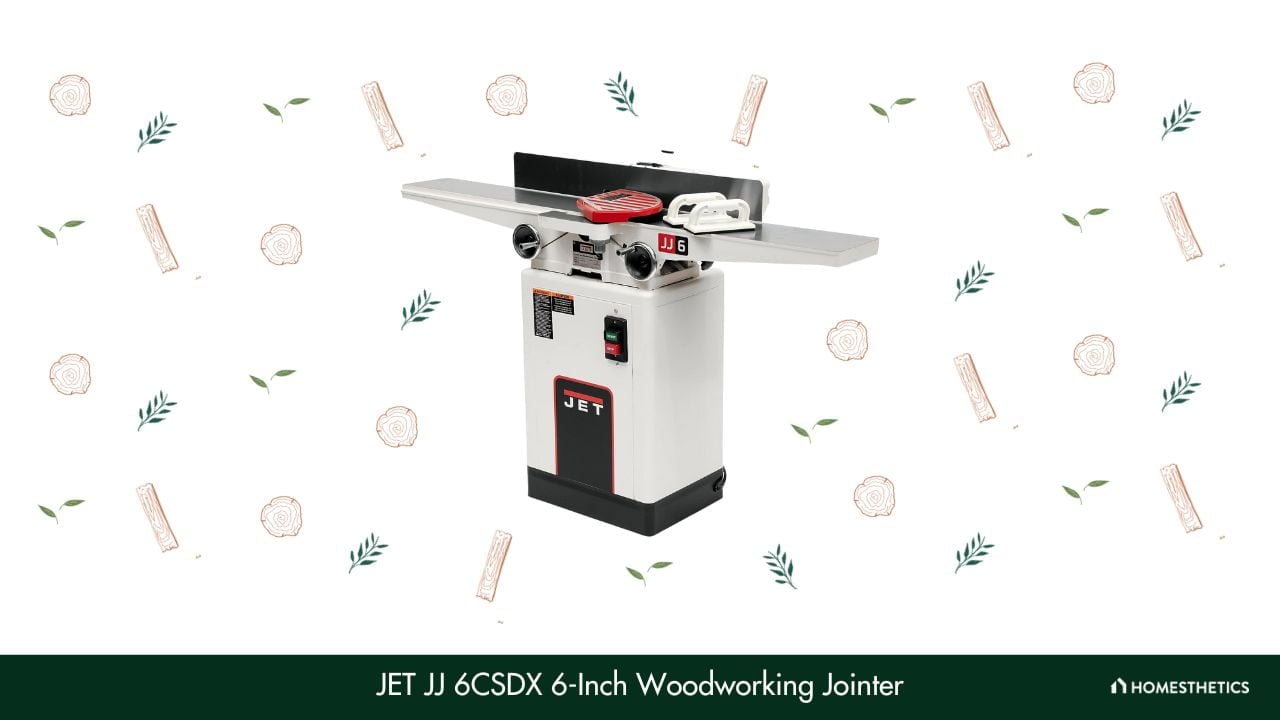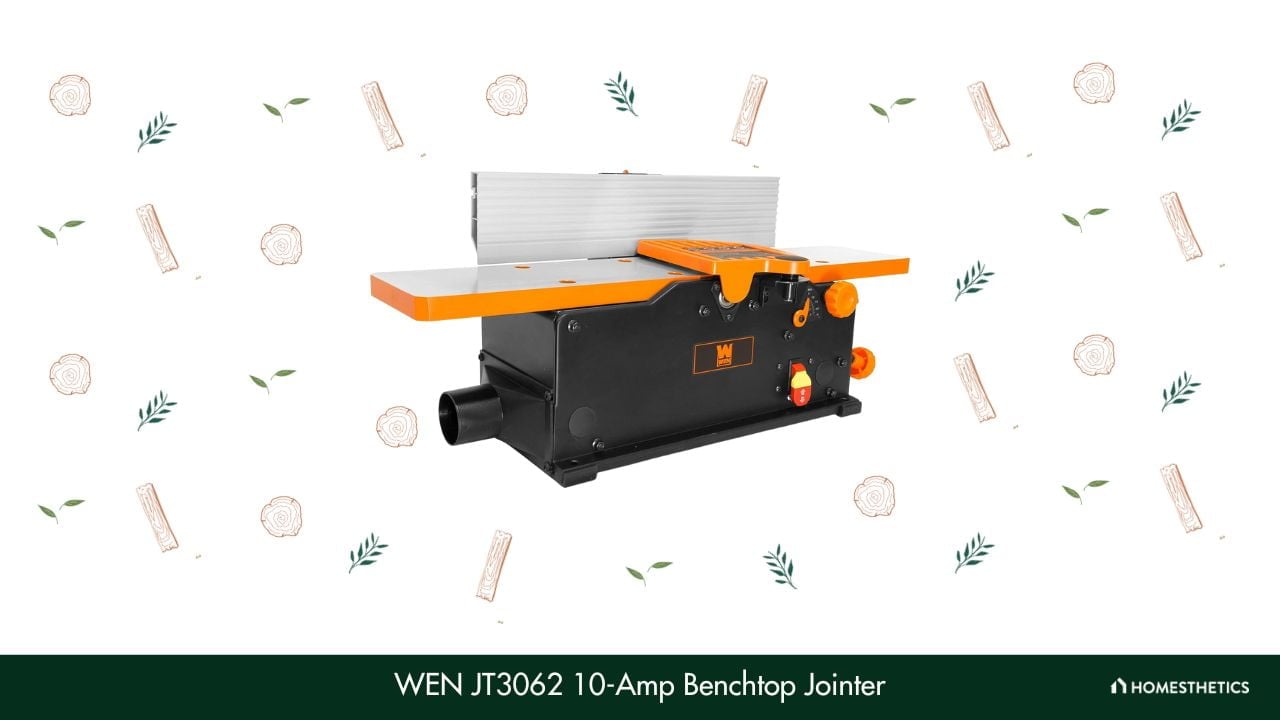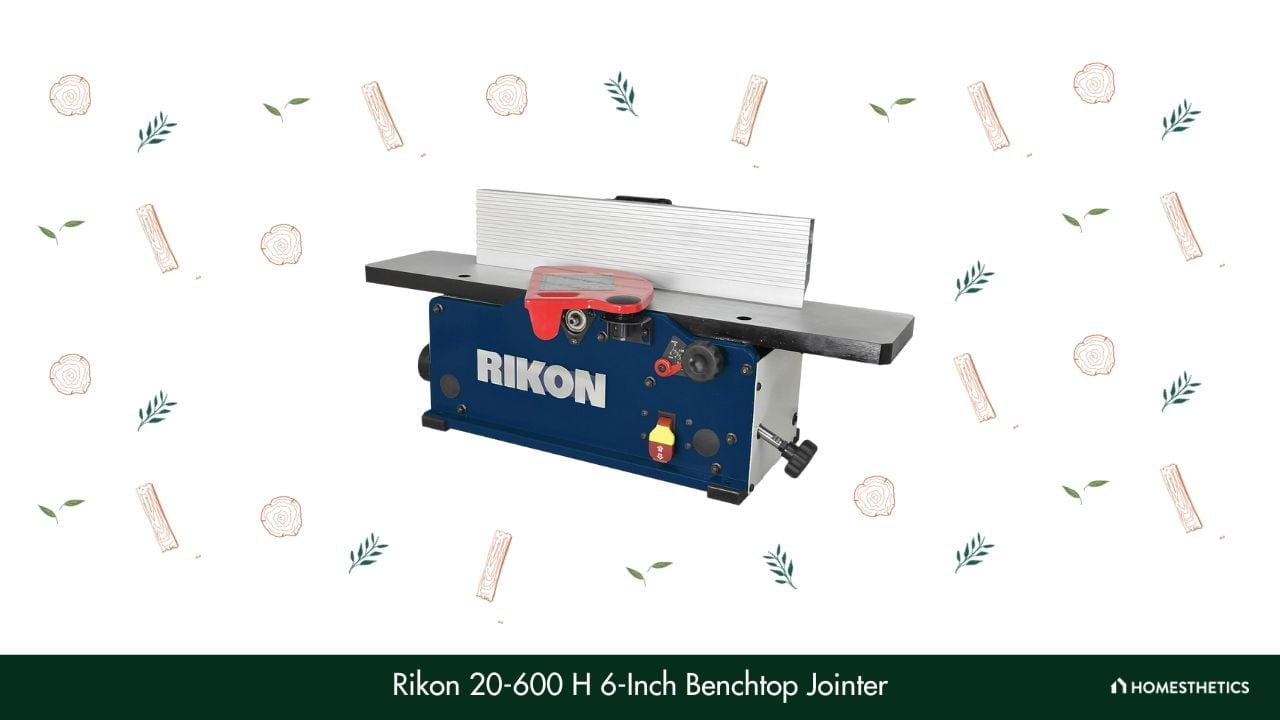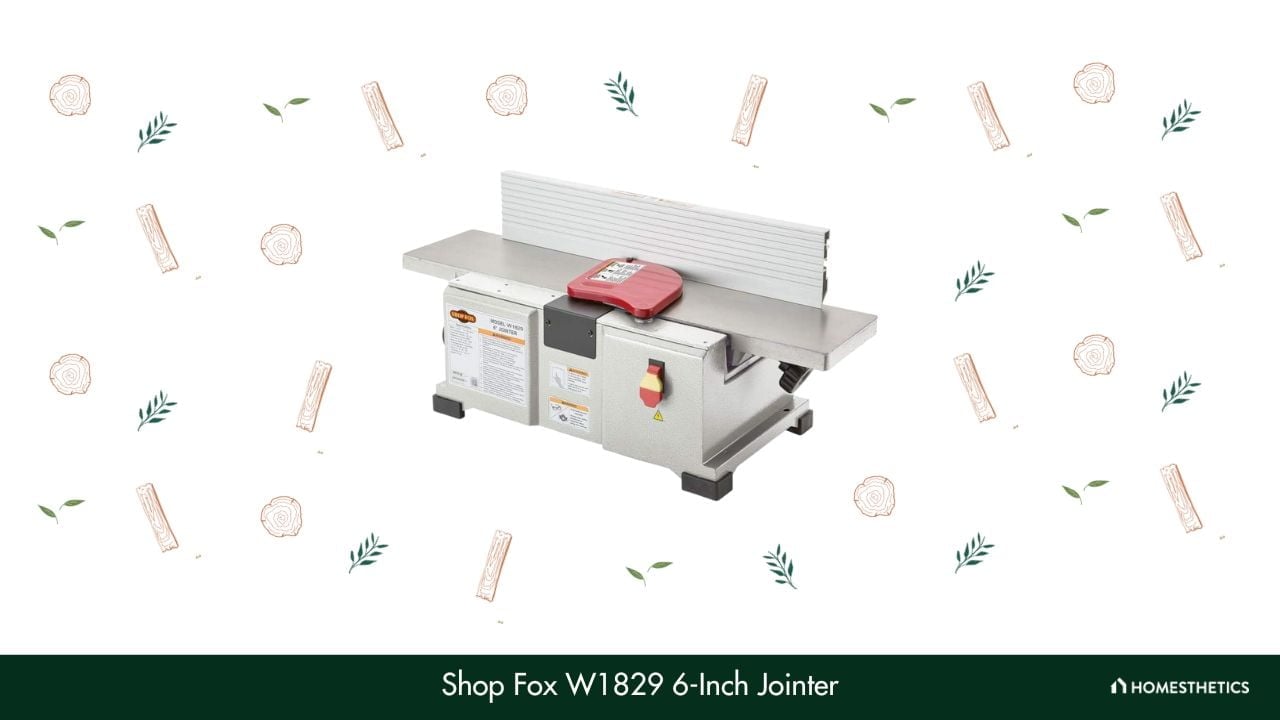The best jointers, whether benchtop or stationary, are essential for flattening faces and squaring edges of rough lumber, ensuring accuracy in furniture-making, cabinetry, or any high-precision woodworking task. Leading the pack, the Porter Cable PC160JT features a variable-speed 10-amp motor and a wide 6-inch cutting capacity, making it an excellent benchtop option for both beginners and experienced woodworkers. Close behind, the WEN JT630H Spiral Cutterhead Jointer stands out for its ultra-clean finishes using efficient HSS spiral blades. While investing in a jointer might seem like a major decision, its ability to eliminate warps and create true edges will dramatically increase the quality and longevity of your woodworking projects. In this guide, we’ve reviewed the 11 best jointers, comparing power, cutterhead types, fence adjustments, and portability. If you’re just getting started, don’t miss our guide on how to install benchtop jointers for setup and accuracy tips.
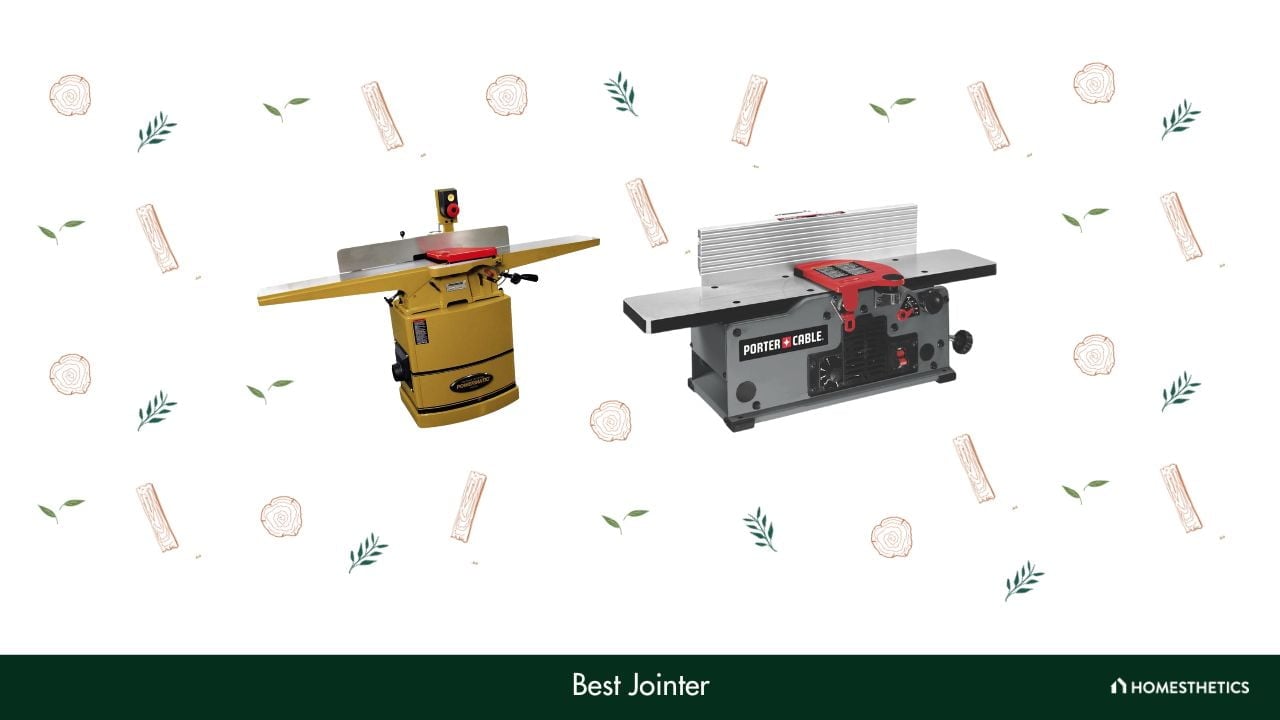
Here are the top stationary and benchtop wood jointers for home:
- Porter Cable benchtop jointer: The Porter Cable offers a variable speed range (6,000-10,000 RPM) and 2-knife cutterheads. Its large table supports up to 6-inch-wide wood, and positive stops ease fence adjustment. At 40 lbs., it's portable with a 4-inch dust port.
- WEN JT630H benchtop jointer: The WEN jointer is an affordable 6-inch jointer with a spiral cutterhead system. The 10-amp motor ensures ample strength, and safety features include a blade guard, push blocks, and a dust port for cleanup.
- Powermatic 60HH 8-inch jointer: The Powermatic jointer excels in accuracy with a helical cutterhead and 54 carbide inserts. While heavy (489 lbs), it offers precise control, a high-mount magnetic switch, and extended workpiece support.
- Craftsman CMEW020 benchtop jointer: The Craftsman features a powerful 10-amp motor (6,000-11,000 RPM) with a 2-knife cutterhead. The portable 40-pound jointer has a 32-inch work surface, tilting aluminum fence, and includes a dust collector.
- JET JJ 6CSDX 6-inch woodworking jointer: The JET jointer boasts a quick-set 3-blade knife system, precise steel cutterhead, and dual-tilt fence (45 and 90 degrees). Industrial controls and a heavy-duty steel stand enhance stability and durability.
1. Porter-Cable benchtop jointer - Best with 2-knife cutterheads
What We Like
- Variable speed range for cutting up different wood sizes
- Extremely lightweight and portable
- Easy to assemble
- Dust port
What We Don't Like
- Not made of durable cast iron
The Porter-Cable PC160JT benchtop jointer features a speed range between 6,000 and 10,000 RPM. So, you can select the perfect speed for working on your chosen material.
Both the knife cutterheads and the leveling arrangement of the jack screw knife make replacing or adjusting the knives extremely simple. This makes it a great feature for beginners.
Drawing from experience, the extra-large jointer table gives sufficient work support and can surface wood stock measuring up to 6 inches wide. This will easily allow you to work with thick boards.
Additionally, this benchtop jointer has positive stops to make your work simple by allowing the fence to be adjusted between 45 and 90 degrees. However, you will have to resquare the fully adjustable aluminum fence after each use.
This benchtop jointer further boasts a 4-inch dust port, which efficiently sucks up all the dust and debris away from the jointer, keeping your workspace clean. Even more, at 40 lbs., this jointer is one of the lightest on this list, offering great portability.
2. WEN JT630H benchtop jointer - Best with blade guard
What We Like
- Affordable for a 6-inch jointer
- Spacious table
- Efficient security
- Includes a dust port to minimize cleanup
What We Don't Like
- The motor is not very powerful
The WEN JT630H benchtop jointer is a great option for home woodworkers. The spiral cutterhead system makes use of the 12 staggered sharp blades that leave behind an ultra-fine finish. And while the 10 motor cannot compete with industrial jointers, it will still provide enough strength for hobbyists and home woodworkers.
After putting it to the test, I found that this jointer provides a great deal of accuracy when it comes to taking off small inches of wood with each cut. All you need to do is adjust the infeed table accordingly, while the expansive table has a length of 30 inches and a width of 6 inches.
Moreover, the blade guard provides protection against any accidental injury as it only exposes a limited section of the cutterhead during a jointing operation. The jointer also comes with two push blocks for safe woodworking and a dust port for cleaning up dust.
3. Powermatic 60HH 8-inch jointer - Best with extended workpiece support
What We Like
- High accuracy and precision
- Easy to control
- Smooth cuts
- Helical cutterhead
What We Don't Like
- Poor customer support
The superior finish of the Powermatic 60HH and a helical cutterhead with 54 four-sided carbide inserts provide smoother and quieter cuts. Its adjustment table offers quick infeed table positioning, giving you fine-tuned cutting depth.
This 8-inch jointer has a 73-inch extended workpiece support, and extra-long tables can be mounted in dovetailed ways. The fence provides smooth tilting along with the handwheel-operated gear system, while a non-mar insert helps to prevent damage to the table due to adjustments.
After using the product, I found that the wood jointer is very easy to control. The high-mount magnetic switch is convenient and easy to reach and the magnetic push blocks are easy to place on the machine, so they are constantly within reach.
However, the machine is quite heavy, weighing 489 pounds, and keep in mind that it won’t be very portable.
4. Craftsman CMEW020 benchtop jointer - Best for fast cuts
What We Like
- Portable
- Expansive speed range
- Excellent table length of 32 inches
- Dust collector included
What We Don't Like
- The fence can be a bit tricky to adjust
Craftsman is a popular brand when it comes to woodworking supplies. And the CMEW020 benchtop jointer surely does not disappoint. It has a powerful 10-amp motor, which features speeds between 6,000 and 11,000 RPM, and a cutterhead that can make up to 12,000 to 22,000 cuts per minute. So, you can choose the perfect speed depending on the hardness of the material.
Moreover, after giving it a go, you will discover that the two straight knives cutterhead with a jackscrew knife, which has the advantage of simple adjustment and replacement. The big aluminum fence can tilt up to 45 degrees, providing plenty of support while cutting.
Weighing in at a manageable 40 pounds, the benchtop jointer offers great portability. At the same time, the jointer can handle boards up to 6 inches in width and has a 32-inch long work surface. Additionally, the jointer also comes with a dust collector that will keep the dust and debris away from your workspace.
5. JET JJ 6CSDX 6-inch woodworking jointer - Best with 3-blade knife system
What We Like
- Durable
- High stability
- Convenient to use
- Easy adjustment
What We Don't Like
- Outdated manual
The JET JJ 6CDX 6-inch stationary jointer has a quick-set knife system, so you can replace or change all three blades in a fraction of the time that other woodworking jointers take. The unique handwheels, placed at the front of the table, make for easy adjustments and accurate corrections.
The jointer uses a precision steel cutterhead with three high-quality knives. These knives have two cutting edges that help to double their life. Additionally, the JJ 6DSDX features a fence that can tilt two ways, stopping at both 45 and 90 degrees. This makes handling bevel operations very simple. Even more, the industrial push-button controls are positioned conveniently to allow for easy access.
Moreover, the heavy-duty, one-piece steel closed stand with mounting tabs offers increased stability and durability. Additionally, after closely examining the product, I discovered that the heavy-duty cast iron infeed and outfeed table gives a precision-machined finish.
6. WEN JT3062 10-amp benchtop jointer - Best with onboard depth scale
What We Like
- Spacious 30-inch table
- Enhanced security
- High speeds
- Powerful motor
What We Don't Like
- The dust port could be better
The WEN JT3062 10-amp benchtop jointer is a great option for beginners looking for an inexpensive and easy-to-use benchtop jointer for their amateur projects. The jointer has a 6-inch wide blade that is powered by a 10-amp motor. This motor provides up to 22,000 cuts per minute, anywhere from 0 to ⅛ of an inch in size.
The onboard depth scale makes for easy adjustments to the depth of the cut. Additionally, the jointer features a 30 by 6- 3/16 inch table. The fence is 19-¾ by 4-¼ and bevels up to 45 degrees.
Even more so, my hands-on review showed that the spring-loaded blade guard and two push blocks provide good security against newbies injuring themselves due to the blade.
Moreover, the machine also includes a dust port to help keep your workspace clean while you are woodworking. However, I find the dust port to not work perfectly all the time.
7. Cutech 40180HB 8-inch spiral head benchtop jointer - Best for staggered inserts
What We Like
- Depth level indicator
- Dust collector
- Lightweight and portable
- Multi-angle adjustable fence
What We Don't Like
- No speed control
The Cutech 40180HB benchtop jointer has a spiral cutterhead that contains 16 staggered inserts for a sweet finish. The versatile 16.5-inch tables extend up to 25.25 inches to offer extra support.
Using this jointer, it’s also very easy to figure out the depth of your cut with the help of the depth level indicator. The red pointer on the indicator will tell you how low the infeed table has been lowered so you can see the quantity of wood that has to be cut off.
Moreover, after seeing it in action, the multi-angle adjustable aluminum fence enables the guide board to move through with the preset at 45 and 90-degree angles. Additionally, you won’t see any table scratches on this hard table, thanks to the durable coating of 6H Teflon.
Lastly, the table is very lightweight, weighing around just 55 pounds, making the jointer quite portable.
8. Rikon 20-600 H 6-inch benchtop jointer - Best for helical cutterheads
What We Like
- Helical cutterheads
- Rigid construction
- Lightweight and portable
- Quick depth setting mechanism
What We Don't Like
- Flimsy infeed and outfeed tables
The Rikon 20-600 H benchtop jointer has 6-row helical cutterheads with 12 HSS and 2-insert cutters for super-cutting action. With its strong 10-ampere motor, this helical cutterhead jointer also features steel insert knives and a spacious 30-inch by 6-3/16-inch table.
Moreover, the table is quite sturdy thanks to its strong metallic construction, and the table is made of machined aluminum, giving the table durability and stability. After testing this woodworking machine, I found that the depth setting mechanism is quite quick, with a fence that is adjustable from 90 degrees to 45 degrees. So, you get speed and accuracy at the same time.
Additionally, this benchtop jointer also has a spring-loaded safety guard and an on/off button in the front, making the jointer secure from any injuries. Even beginners can use it in the workshop without any difficulty.
9. Shop Fox W1829 6-inch jointer - Best for free safety push blocks
What We Like
- Precise and accurate cuts
- Dust collector
- Easy-to-adjust fence
- Rigid construction
What We Don't Like
- Installation instructions could be better
The Shop Fox W1829 jointer works on a single motor that gives a 12-Amp power and 1-½ horsepower. The speed of the cutterhead is about 10,000 RPM, serving about 20,000 cuts per minute. And even though the cutterhead is just two knives, it still gives an accurate and precise cut every single time.
The fine-adjusted infeed table knob will enable you to control the cutting depth and is adjustable according to the workpiece you are processing. Additionally, the jointer comes with a dust collector that will keep your workshop free from wood shavings or dust.
Moreover, the jointer includes a pair of free safety push blocks, a built-in dust collection fan, and a dust collection bag. Based on my trials, the easy-to-adjust fence has stops that simplify the task of adjusting to 45 degrees inward, 90 degrees, and 45 degrees outward.
Lastly, this benchtop jointer is made from rigid cast iron, giving stability and hardness to the entire woodworking process.
10. Wahuda 10-inch spiral cutterhead benchtop jointer - Best with 4-side carbide inserts
What We Like
- Hassle-free adjustments
- Long-lasting blades
- Low noise operation
- User-friendly set-up
What We Don't Like
- Fixed speed
This Wahuda jointer will help you produce surfaces and edges that are perfectly flat. This benchtop jointer will help you create extremely smooth and accurate cuts on rough or uneven pieces of wood. The spiral cutterhead consists of 4-side carbide inserts, which allow for sharper and more precise cuts while operating quietly at the same time. Additionally, the standard blade size also allows for simple and cost-effective replacement.
Moreover, the jointer works on a 120V motor, having a static speed of 12,000 RPM. Thus, you can edge, joint, taper, or flatten any surface that you want.
More so, I learned from my time with it that you can extend the already spacious cast iron tables for higher rigidity, even when working on longer and larger pieces. The fence can tilt from 90 degrees to 135 degrees for versatility.
To make your woodworking projects a lot easier, you can also buy Wahuda jointers in the 6-inch and 8-inch variations.
11. Grizzly Industrial G0947 8-inch benchtop jointer - Best with 2-sided HSS knife inserts
What We Like
- Lightweight and portable
- Adjustable table extensions
- 8-inch infeed and outfeed extensions
- Two push blocks are included
What We Don't Like
- Durability could be better
The Grizzly Industrial G0947 8-inch benchtop jointer is equipped with an 8-inch spiral cutterhead. With this jointer, you get a high degree of space utilization and the power of a floor jointer at the same time. The lightweight of the jointer makes it possible to transport between locations and makes for easy storage.
After trying it in various situations, I discovered that the spiral cutterhead works at a lower noise level, requires fewer repairs, and results in smoother cuts, compared to a straight knife cutterhead. Each of the 16 two-sided HSS knife inserts can be moved around to reveal a sharper edge.
Moreover, the adjustable table extensions allow you to easily expand the table length from 34 inches to 52 inches. This will allow you to produce longer and straighter edges than you can with other benchtop jointers.
What are the best jointers for home woodworking projects?
Below is a table that lists the best jointers for home woodworking projects. It provides comparisons of various factors, including cutting width, motor power, cutterhead design, table length, and other specific details.
| Jointers | Type | Cutting Width | Motor Power | Cutterhead Design | Table Length | Adjustability and Fence | Dust Collection | Safety Features |
|---|---|---|---|---|---|---|---|---|
| Porter Cable PC160JT | Benchtop | 6" | Around 1.3 to 1.5 HP | Two-knife | 30" | Can be moved across the table, 45° and 90° adjustability | Built-in dust collection port | Push blocks, cutterhead guard, built-in cutterhead lock |
| WEN JT630H | Benchtop | 6" | 1.6 HP | Spiral | 30" | Bevels up to 45° | 2.5" onboard dust port | Push blocks, spring-loaded blade guard |
| Powermatic 60HH | Freestanding | 8" | 2 HP | Helical | 73" | Tilts 45° forward and 45° backward | 4" dust collection port | Push blocks, cutterhead guard |
| Craftsman CMEW020 | Benchtop | 6" | Around 1.3 to 1.5 HP | Two straight knives | 30" | Center-mounted, tilts 45° | Built-in dust collection port | Cutterhead guard, built-in cutterhead lock |
| JET JJ 6CSDX | Freestanding | 6" | 1 HP | Three-knife | 56" | Tilts two-way | Built-in dust chute with 4" port | Push blocks, cutterhead guard |
| WEN JT3062 | Benchtop | 6" | 1.6 HP | Straight knife | 30" | Bevels up to 45° | 2.5" dust port | Push blocks, spring-loaded blade guard |
| Cutech 40180HB | Benchtop | 8" | Around 1.3 to 1.5 HP | Spiral | 16.5" (extendable to 51”) | Multi-angle adjustable | 4" dust port, 2.5" adapter | Push blocks, cutterhead guard |
| Rikon 20-600H | Benchtop | 6" | Around 1.3 to 1.5 HP | Helical | 30'' | Tilts from 90° to 45° | 2.5" dust port | Front safety on/off switch, spring-loaded safety guard, push blocks |
| Shop Fox W1829 | Benchtop | 6" | 1.5 HP | Two-knife | 28.5" | Can be adjusted 45° inward, 90°, and 45° outward (135°) | 2.5" dust port, built-in mini impeller-driven dust collection fan, collection bag | Push blocks, cutterhead guard |
| Wahuda Benchtop Jointer | Benchtop | 10" | Approx. 1.6 HP | Spiral | 30'' | Tilts 90° and 135° | 4" dust port, 2.5" adapter | Push blocks, blade guard |
| Grizzly Industrial G0947 | Benchtop | 8" | 1.5 HP | Spiral | 34" (extendable to 52”) | Tilts up to 45° | 4" dust port, 2.5" adapter | Push blocks, cutterhead guard |
Jointers buyer’s guide
A jointer is the best option when you have to create flat surfaces and edges while working on wood. But buying a jointer can be quite confusing at the beginning due to all the different features and sizes available. Should you get a benchtop jointer or a stationary jointer? One having a spiral cutterhead or a helical cutterhead?
So, to help you make the right decision, here is a buyer’s guide to let you know which factors you should look out for when buying a jointer.
1. Type - Benchtop or stationary
There are basically two types of jointers you can buy for your woodworking- benchtop and stationary. Let’s discuss each of the two types in detail so you know which one would be the perfect type for you.
A benchtop jointer is smaller in size and more compact. Its lightweight makes it portable, making it a good option for hobbyists or home woodworkers. It is great for those woodworkers who don’t require the power of industrial jointers for their work.
Due to their compact size, a benchtop jointer generally requires less power. They are also not as durable as stationary jointers because they are made using lighter and cheaper materials.
A stationary jointer, on the other hand, is heavier and larger in size. They are not very portable, obviously, but work on industrial-grade power. So, a stationary jointer is perfect for an experienced professional. And although they are more expensive, they also offer high accuracy and durability.
So, depending on your woodworking skills, needs, and workspace, you should choose the type that suits your requirements the most. A benchtop jointer is a great option for a hobbyist or a beginner, while a stationary jointer is a better option for experienced professionals who work on high volumes.
2. Size
As a woodworker, you must be well aware of the typical size of wood pieces you usually work on. This knowledge is important since it will help you choose the right size of jointer for your woodworking activities. Do remember that the size of your jointer depends on the size of your blades.
So, this measurement will help you decide which jointer size would be the perfect one for you. Here are some of the common sizes of jointers available for you to choose from:
A. 6-inch
This is the smallest jointer size you can buy, making it great for hobbyists and beginners. They are extremely lightweight and portable. Even though they are small, you can still easily use these machines for both professional and home applications.
B. 8-inch
The 8-inch jointers are slightly bigger than the 6-inch ones and can handle larger wood pieces. Obviously, this makes them a bit more expensive than the 6-inch jointers.
C. 16-inch
The 16-inch jointers are the largest jointers you can find on the market. The large size makes them suitable for industrial applications and bigger operations. They also have longer blades to take bigger sizes of wood. The big sizes of the blades make them highly versatile.
3. Knife/Cutterhead
You might have noticed that different jointers have different types of blades attached. Some are straight blades, while others have spiral or helical cutterheads. The cutterhead helps to ensure that your jointer is functional.
Benchtop jointers usually use straight blades, having two or more rows of blades that run straight across the cutterhead. But, they tend to undergo wear and tear pretty quickly and require replacement again and again.
Some jointers use a spiral cutterhead, which is spiral in shape (obviously), and use 4-sided cutters. The blades all sit parallel to the axis of the cylinder. Spiral cutterheads produce highly precise cuts and are extremely effective.
Changing spiral cutterheads is also pretty easy. On top of that, they work quietly since they require low power to run. Additionally, they help save time and leave close to no marks on the board.
In helical cutterheads, on the other hand, each blade sits 14 degrees off the cylinder’s axis. This helps produce a very smooth and neat finish.
4. Portability
Most of the jointers on this list consist of a cast-iron construction. And while providing durability and stability, a cast iron jointer can be extremely heavy and difficult to transport from one place to another. This greatly hinders the portability of the jointer. After all, who would (and could) want to carry around a jointer weighing around 300 pounds?
If the portability of the jointer is an important factor for you, I suggest you get a benchtop jointer. But remember that a benchtop jointer too, can weigh anywhere between 60 and 100 pounds. So, that would be quite difficult to transport around, too. But I reckon it is certainly better than a 300-pound jointer, right?
5. Cutterhead speed
The cutterhead speed is denoted as the cuts per minute or CPM. The faster the cutting speed, the faster is the work. So, you will require less time to complete a workpiece if the cutterhead speed of your jointer is high. Mostly, the cutterhead speed tends to be higher than the motor’s speed.
6. Dust collection
Any kind of woodworking procedure is bound to produce a lot of sawdust and splinters. And this particulate matter can actually lay down hindrances in your work, by causing breathing problems and creating a mess of everything. This is why many woodworkers prefer to get jointers that include a dust collection system.
Dust collection ports also vary in size. So, depending on the amount and type of woodworking you intend to do with your jointer, get a dust collection of the appropriate size to keep your workspace neat and clean.
7. Cutting depth
The cutting depth of your jointer is another crucial aspect you should consider when buying a jointer. Remember that the cutting depth will decide how many times you can cut and also the cutting speed. If the depth of the cut is big enough, it will help save you a lot of time.
Most benchtop jointers have a system in place that allows you to adjust the cutting depth. But some jointers don’t. This inability to adjust the cutting depth can greatly obstruct the number and types of wood projects you can undertake with this jointer.
So, it is better that you get a jointer that allows a wide range of cutting depths. This will help to increase the versatility of your jointer.
8. Infeed and outfeed tables
The length of the infeed and outfeed tables of your jointer will greatly affect the sizes of wood pieces you can work with. So, this is another important thing to consider before you buy a jointer. The usual length of a benchtop jointer is 28 inches. However, if you do require a long table, you might have to choose a stand-mount table instead.
The width is another important factor to consider since that will also affect the size of the wood piece the jointer could accommodate. The width of a benchtop jointer usually lies between six and eight inches. Remember that the wider and longer the table, the greater the versatility.
Additionally, don’t forget to check the materials with which the infeed and outfeed tables are made. The more durable the materials, the better. Materials like stainless steel and cast iron offer much-needed stability and durability to the jointer. They can withstand the high pressure that comes with woodworking.
9. Power
Power will determine the ease and speed of cutting. Since a high-powered jointer can cut through wood with more ease, it produces smoother and neater work than low-powered models.
Most of the jointers run on 1 or 2 horsepower, while the exceptional jointer might run on 3 horsepower. Low power wouldn’t really affect the speed, but it will affect the ease and time taken for cutting. So, according to the type and amount of woodworking you intend to do, choose the appropriately powered jointer.
10. Fence
A fence is a part of each benchtop jointer, and it helps to produce quieter, smoother, and more efficient work. You can easily change the fence’s angle, thanks to the positive stops. You just need to ensure that the fence is sturdy, flat, and robust when selecting the jointer you are buying.
The size of your fence will also decide the smoothness of your cuts. For instance, you could need support for some of your jobs that are skewed. This is why you should get a fence that can stop at specific angles (like 45 degrees, 90 degrees, and 135 degrees), enabling you to make precise cuts at all these angles.
11. Material
Last, but definitely not the least, comes the matter of material. Obviously, you should choose a durable and sturdy material for your jointer. What would it matter if the jointer itself starts to sag or bend when you are attempting to square a piece of wood? So, look for cast iron and stainless steel joint boards for enhanced stability. longevity and durability.
Do I really need a jointer?
Whether you really need a jointer or not depends on the nature of your woodworking projects. A jointer is one of the most useful woodworking tools, which is used to make flat and smooth surfaces of wood boards. If that seems like something that is required in your woodworking process, you should definitely get a jointer.
A jointer will help to improve the efficiency and accuracy of your woodworking. It will definitely help to improve the quality of all of your woodworking projects.
What are the benefits of using a jointer?
Here are some of the benefits of using a jointer:
- Increase the quality of wood by removing twists and warps
- Make the surface of wood smooth and shiny
- Keep a clean workspace with the help of the dust collector
- The leftover wood shavings can be used for other woodworking projects
- Helps to save overall time taken by the woodworking project
How should I use a jointer?
To use a jointer, first, you need to make sure that the joint between the guide fence and the outfeed table measures exactly 90 degrees. This can be done using a shop square. After all, the point of a jointer is to make a perfect square edge. Without the 90 degrees, that won’t be possible.
Now, adjust the depth of the cutterhead to your desired level. Then fix the wood stock on the infeed table with the crown side up. Now, you can turn on the jointer. Ensure that you cut the face first and then move on to the edges.
Keep the wood stock pushed firmly against the fence, and push the wood through the cutter using the push pads at the same time. Next, cut the other face, followed by the edges.
Tada! If you perform all those steps correctly, you will end up with a perfectly square piece of wood with all four sides smooth. So, operating a jointer doesn’t seem so difficult now, does it? Hopefully, you got the hang of it. And even if you don't, practice will take you a long way.
What is the difference between a planer and a jointer?
Here's the difference between a planer and a jointer - A planer will help you have equal thickness when you cut straight wood. One side of the board must already be flat in order to use a planer. On the other hand, a jointer is used to perfect square pieces of wood out of uneven or twisted pieces.
A planer and a jointer might seem similar at first glance. They both help to remove wood from the sides of any wood stock but they produce quite different results.
Of course, you can always buy jointers that not only perform the function of a jointer perfectly but also perform the functions of a planer.
How can I sharpen the jointer blades myself?
You can sharpen the jointer blades yourself. You can just use a simple jig to hold the two knife cutterheads in place. This way, you will be able to sharpen the blades without even uninstalling them. As for the jig, you can either purchase a readymade one or you can fashion one using a small piece of hardwood.
After you procure the jig, you can sharpen the jointer blades yourself in the following way:
First, cover the edges of the outfeed table with thick tape to protect them from any damage during the sharpening process. After holding the blade in place using the jig, move the cutterhead to the proper depth to begin sharpening. Now, place a piece of wood on the cutting table and lower the outfeed table until the blade just makes contact with the wood.
Next, get a 600-grit diamond sharpening stone and begin to sharpen the jointer blade by placing the stone on the blade and then drawing it back in the direction of the outfeed table. Keep doing that till you end up with a small bevel across the length of the blade. You can use a magnifying glass to check the blade.
Now, switch to a 1200-grit stone and repeat the aforementioned process. After sharpening that particular blade, you can just remove the jig and place it on the next blade. Repeat this process till all the blades are sharpened.
You can always send out your jointer blades to get sharpened professionally, but that is a costly option. Apart from the expenses, your jointer blades might not be available to you for weeks. And that is not a good option when you want to continue doing your work.
It is time to highlight my favorite products from the list. In first place, we have the Porter Cable PC160JT benchtop jointer equipped with variable speed range, large workspace, effective portability, and an efficient dust port, which makes it worthy of the top spot.
In second place is the WEN JT630H, with its spiral cutterhead and efficient cutting depth level system. Or, if you prefer a helical cutterhead, in third place we have the Powermatic 60HH jointer due to its extendable workspace and easy-to-use controls.
I hope this guide helped you figure out which jointer would be the best for you. In the end, the jointer should improve the efficiency of your woodworking and make it easier.
Check out our other articles on the best stationary planers and hand planers available in the market to learn more about woodworking tips.

